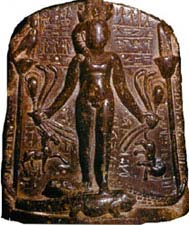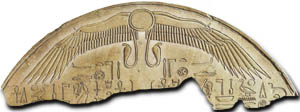Symbols: hawk/falcon, bull, Double Crown, Winged Disk, Udjat, Sphinx, weapons, iron, blacksmiths
Cult Center: Edfu, Buto andHeliopolis
Myths: Isis and Osiris
The falcon-headed god, the kings of Egypt associated themselves with Horus. Horus was among the most important gods of Egypt, particularly because the Pharaoh was supposed to be his earthly embodiment. Kings would eventually take the name of Horus as one of their own. At the same time, the Pharaohs were the followers of Re and so Horus became associated with the sun as well. To the people this solar deity became identified as the son of Osiris. Attempts to resolve the conflicts between these different gods in different parts of Egypt resulted in at least fifteen distinct forms of Horus. They can be divided fairly easily into two groups, solar and Osirian, based on the parentage of the particular form of Horus. If he is said to be the son of Isis, he is Osirian; otherwise he is a solar deity. The solar Horus was called the son of Atum, or Re, or Geb and Nut variously.
As Harsiesis, he is "Horus, the son of Isis". Horus was conceived magically by Isisfollowing the murder of his father, Osiris. Horus was raised by his mother on the floating island of Chemmis near Buto. He was in constant danger from his evil uncle Sethbut his mother protected him and he survived.
 As a child, Horus was known as Harpokrates, "the infant Horus", and was portrayed as a baby being suckled by Isis. He was said to be stunted from the waist down. This may be because his father was dead when he was conceived or perhaps because he was born prematurely. In later times he was affiliated with the newborn sun. Harpokrates is pictured as a child sucking his thumb and having his hair fashioned in a sidelock that symbolized his youth. On his head he wore the royal crown and uraeus. Also, in Egyptian art, such as the example to the right, Harpokrates is shown as a child with the sidelock of youth standing on crocodiles and holding in one hand scorpions and in the other hand snakes.
As a child, Horus was known as Harpokrates, "the infant Horus", and was portrayed as a baby being suckled by Isis. He was said to be stunted from the waist down. This may be because his father was dead when he was conceived or perhaps because he was born prematurely. In later times he was affiliated with the newborn sun. Harpokrates is pictured as a child sucking his thumb and having his hair fashioned in a sidelock that symbolized his youth. On his head he wore the royal crown and uraeus. Also, in Egyptian art, such as the example to the right, Harpokrates is shown as a child with the sidelock of youth standing on crocodiles and holding in one hand scorpions and in the other hand snakes.
As Harmakhis, "Horus in the Horizon", he personified the rising sun and was associated with Khepera as a symbol of resurrection or eternal life. The Great Sphinx at the Giza Plateau is an example of this form of Horus.
Haroeris, "Horus the Elder", was one of the earliest forms of Horus and the patron deity of Upper (southern) Egypt. He was said to be the son, or sometimes the husband ofHathor. He was also the brother of Osiris and Seth. He became the conqueror of Seth (the patron of Lower Egypt) c. 3000 BCE when Upper Egypt conquered Lower Egypt and formed the united kingdom of Egypt. He was depicted as a falcon-headed man, sometimes wearing the crowns of Upper and Lower Egypt.
Horus (the elder) had numerous wives and children, and his 'four sons' were grouped together and generally said to be born ofIsis. The four were known as: Duamutef,Imsety, Hapi and Qebehsenuef. They were born from a lotus flower and were solar gods associated with the creation. They were retrieved from the waters of Nun by Sobekon the orders of Re. It was believed thatAnubis gave them the funerary duties of mummification, the Opening of the Mouth, the burial of Osiris and all men. Horus later made them protectors of the four cardinal points. In the Hall of Ma'at they sat on a lotus flower in front of Osiris. Most commonly, however, they were remembered as the protectors of the internal organs of the deceased. Each son protected an organ, and each son was protected by a goddess.

Horus Behdety was a form of Horus the Elder that was worshipped originally in the western Delta at Behdet. As the son and heir of Re, Behdety was a form of Horus that was assimilated into the Heliopolitan system of beliefs yet not completely identified with Re. Behdety was a defender ofRe during his earthly kingship against Seth. He was usually portrayed as a winged sun-disk or as a falcon hovering over the Pharaoh during battles. When shown as a falcon-headed man wearing the double crown he carries a falcon-headed staff, the weapon he used to defeat Seth.
your post was very long, try to shorten it up a little and make it so that it captures the readers attention better. but other that that, good facts
ReplyDeleteI like how detailed this is. I feel like anyone who read this would have a clear understanding of who Horus is.
ReplyDeleteThis was extremely detailed! Which was nice... when you read it you knew exactly who Horus was.
ReplyDelete